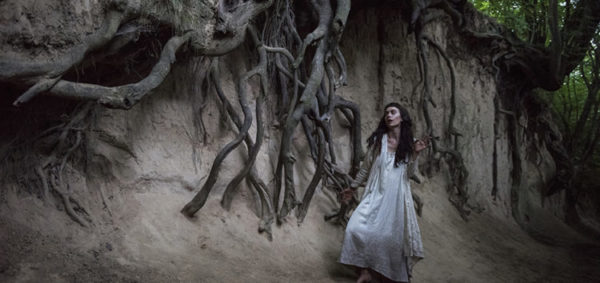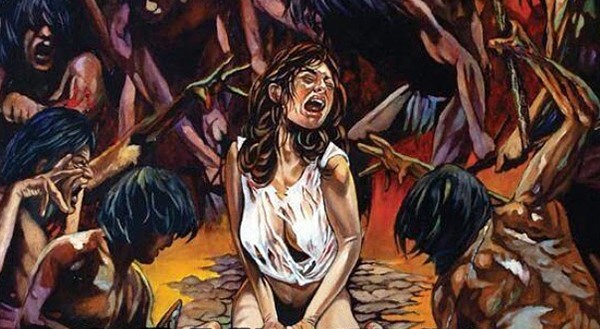The Field Guide To Evil. 2019.
Directed by Ashim Ahluwalia, Can Evrenol, Severin Fiala, Veronika Franz, Katrin Gebbe, Calvin Reeder, Agnieszka Smoczynska, Peter Strickland, and Yannis Veslemes.
Starring Birgit Minichmayr, Sarah Navratil, Claude Duhamel, Jilon VanOver, Vangelis Mourikis, Thomas Schubert, Niharika Singh, and Kannon Hicks.
SYNOPSIS:
A feature-length anthology film. They are known as myths, lore, and folktales. Created to give logic to mankind’s darkest fears, these stories laid the foundation for what we now know as the horror genre.

As a lover of horror anthologies, it brings me no joy to find The Field Guide To Evil more rewarding in concept than practice. Eight different tales of worldwide urban legends, myths, and folklore from native filmmakers representing multiple countries. Germany, Poland, Turkey and more divulge their richest tradition-based fears, falling harder than most into the “mixed bag” nature of shorthand cinematic collaborations. Perfect lineups are rarer than spotting the Jersey Devil – typically always at least one bad apple – but this specific collection is a sleepy bedtime antidote instead of page-turning nightmare fuel. Let’s jump right into the segments as they unfold.
Austrian duo Veronika Franz and Severin Fiala present “The Sinful Women of Höllfall,” which sustains The Witch vibes in one of many European countryside villages. A story of blasphemous same-sex temptation and shame at the hand of puritanical congregations, but guilt turns into nightly monstrosities in faith-based period fashion. “Pray, it’s all you can do.” Easily one of the more cinematic offerings in The Field Guide To Evil, featuring some wicked imagery when “Big Mouth” comes calling – standard old-world religious paranoia and moral aberration panic.
Can Evrenol’s “Al Karisi” segment, based on a Turkish childbirth djinn tale, stands as a shining example of what anthologies *can* accomplish. It’s reminiscent to Satan’s Slaves (which I screened just before my first The Field Guide To Evil watch) in that Evernol’s family-based horrors are unspeakably traumatizing. Easily the scariest of all the segments offered. Shades of Baskin define only in demonic representation, as Evernol proves he can mold generations-old folklore into something vicious – just be wary if you’re an animal lover. Not like the child endangerment is enough, or anything (Evernol strikes for the jugular and lands a precise strike).

Agnieszka Smoczynska, of The Lure fame, brings us “The Kindler And The Virgin.” If anything, it assures Smoczynska as a magnetic talent who only attracts the most beautifully drawn-up cinematic ideas. It’s just at such a rapid pace, shortsightedness never paints a complete picture. Ambition, trophy meals, and cannibalism accent this almost hallucinogenic daze, but horror anthology swiftness cuts Smoczynska’s ethereal horror pop at the legs.
American-bred Calvin Reeder brings us the story “Beware The Melonheads,” a Midwestern myth about outcast woodland children with bulbous craniums. Deformed kiddos, unsuspecting parents, and some pretty questionable production values define this fairly dead-space throwaway. Cinematography feels stuffy despite sunny settings, and there’s not a drip of flesh-munching tension. Unfortunately one of the weaker presentations an already struggling The Field Guide To Evil puts forth, opening and closing without lasting impact.
Yannis Veslemes’ “Pangas The Pagan” may be the most spirited of the bunch, but at times feels like a high school theater production. I should love a festive ceremonial romp involving goblins, alcohol, and “ghettoblasters,” but Veslemes’ energy never channeled my wavelengths. You’re either in from the start or left in the cold, as an outsider finds his way amongst human brutes. Not my speed, but will assuredly be a favorite amongst certain mythology crowds.

Ashim Ahluwalia’s black-and-white “The Place Of Horrors” does its best to represent India, but feels so unforgivably out-of-place. An agent for circus corporations goes deep-diving into ruined temples to find showpiece creatures, but so many negatives work against Ahluwalia’s objective. Dialogue lands without enthusiasm, performances are (again) lackluster, and oh how underwhelming a payoff. “The Place Of Horrors” is one of those dull exemplifications of lower-budget horror anthology restraints, and worse, fails to navigate around any such obstacles.
Katrin Gebbe represents Germany with “A Nocturnal Breath,” a short reprise from the downslope since “Al Karisi.” Adrude is an evil entity who possesses souls and exits their body to spread disease, leaving the vessel lifeless. Gebbe’s representation is that of a farmer and his lover; Adrude shown as a scampering mouse. Love, plagues, and sucking the rodent from your partner’s mouth to keep her alive. “A Nocturnal Breath” gets squeamish and honors the tradition of folklore through visual and thematic darkness – until ending abruptly like most segments.
Peter Strickland’s “The Cobblers’ Lot,” to no shock based on the filmmaker’s past works (The Duke of Burgundy/Berberian Sound Studio), gets certifiably weird. Once again I’ll use the stage production aesthetic as brothers and princesses play into zany romantic entanglement that’s bizarre, unique, and such a strange finishing note. “The Cobbler’s Lot” entertains, but clashes against rival segments in terms of cohesion. An inspired choice, just not one that benefits (borderline at times) horror anthology ties as a whole despite fans of Strickland leaving happy.

The Field Guide To Evil is an impressive collection of talents, and equally energized anthology concept, but that makes this continuous decline even more disappointing. Balance feels wonky as wrap-around introductions read a descriptive passage for the cultural tales about to play out, each segment either too short or oddly placed or hurriedly conceived. Evernol stands proudest, Austria represents, but too many other nations plant their flag into cursed soil. Hopefully future installments aren’t shelved because I’d love another shot at such an inclusive endeavor – admittedly not the brightest of starts.
Flickering Myth Rating – Film: ★ ★ / Movie: ★ ★
Matt spends his after-work hours posting nonsense on the internet instead of sleeping like a normal human. He seems like a pretty cool guy, but don’t feed him after midnight just to be safe (beers are allowed/encouraged). Follow him on Twitter/Instagram/Letterboxd (@DoNatoBomb).












